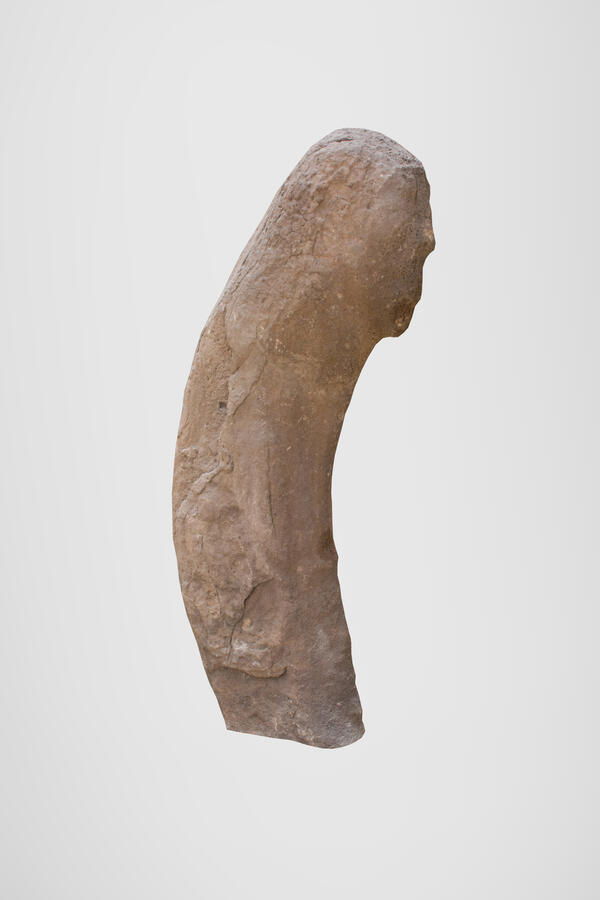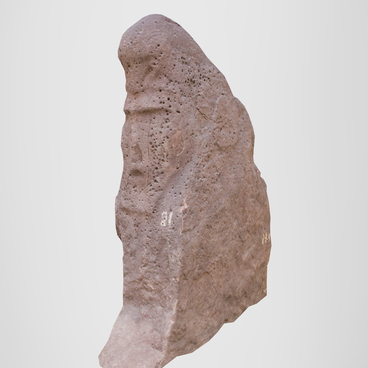“Khys tas” in Khakass language means a “stone girl”. This two-meter stela was made of Devonian sandstone, presumably at the end of the 3rd millennium — the beginning of the 2nd millennium BC. It belongs to the South Siberian archaeological Okunev culture, named after the Okunev ulus, where the burial ground of this culture was first excavated.
Initially, the statue was located on the left bank of the Tyoya River near the Mergen-aaly ulus, by the ford on an old road. One of the traditional Khakass settlements Teren Chin aal was located on the right bank. Later, this “khys tas” was two or three kilometers above the mouth of the Es river on the way to the village of Tashtyp. In 1953, archaeologist Albert Lipsky transported it from the village of Poltakov in the Askiz district of Khakassia to the Khakass Regional Museum of Local History.
The master gave the sandstone an oval cross-section and a slightly curved, arched shape, which is why some researchers have compared it to a phallus. At the very top of the statue, an expressive anthropomorphic head of a deity with round ears and a large bald spot framed by loose hair was carved. On the left side, one can see a pair of rings resembling the temple rings of the national costumes of Khakass women, or an ear with an inserted circular temporal ring.
The master divided the face of the deity into two parts by a line between the nose and mouth. In the upper part of the mask, he placed three eyes. He marked two of them with holes and circles, above which he put two horizontal lines — eyebrows. He made the third eye on his forehead in the form of a circle. In the center of the upper part of the mask, he placed a relief nose with nostrils. On the sides of the nose, he drew curved lines that accentuated the raised cheekbones. In the lower part, he placed a relief oval mouth with two corners along the edges. Below the mouth, on the chin, he made a horizontal stripe.
Just below the chin of the statue is a sign in the form of a circle with four rays, endowed with the eyes and mouth of a person, horns and ears of a bull.
The upper mask hangs over the lower one, which is strongly weathered. It is also split in two by a line running down the center through the nose. In the upper part of the lower face, two eyes were placed, which were designated by holes and circles. In the center — a relief triangular nose, and in the lower part — an oval mouth in the form of a continuous depression.
Initially, the statue was located on the left bank of the Tyoya River near the Mergen-aaly ulus, by the ford on an old road. One of the traditional Khakass settlements Teren Chin aal was located on the right bank. Later, this “khys tas” was two or three kilometers above the mouth of the Es river on the way to the village of Tashtyp. In 1953, archaeologist Albert Lipsky transported it from the village of Poltakov in the Askiz district of Khakassia to the Khakass Regional Museum of Local History.
The master gave the sandstone an oval cross-section and a slightly curved, arched shape, which is why some researchers have compared it to a phallus. At the very top of the statue, an expressive anthropomorphic head of a deity with round ears and a large bald spot framed by loose hair was carved. On the left side, one can see a pair of rings resembling the temple rings of the national costumes of Khakass women, or an ear with an inserted circular temporal ring.
The master divided the face of the deity into two parts by a line between the nose and mouth. In the upper part of the mask, he placed three eyes. He marked two of them with holes and circles, above which he put two horizontal lines — eyebrows. He made the third eye on his forehead in the form of a circle. In the center of the upper part of the mask, he placed a relief nose with nostrils. On the sides of the nose, he drew curved lines that accentuated the raised cheekbones. In the lower part, he placed a relief oval mouth with two corners along the edges. Below the mouth, on the chin, he made a horizontal stripe.
Just below the chin of the statue is a sign in the form of a circle with four rays, endowed with the eyes and mouth of a person, horns and ears of a bull.
The upper mask hangs over the lower one, which is strongly weathered. It is also split in two by a line running down the center through the nose. In the upper part of the lower face, two eyes were placed, which were designated by holes and circles. In the center — a relief triangular nose, and in the lower part — an oval mouth in the form of a continuous depression.



